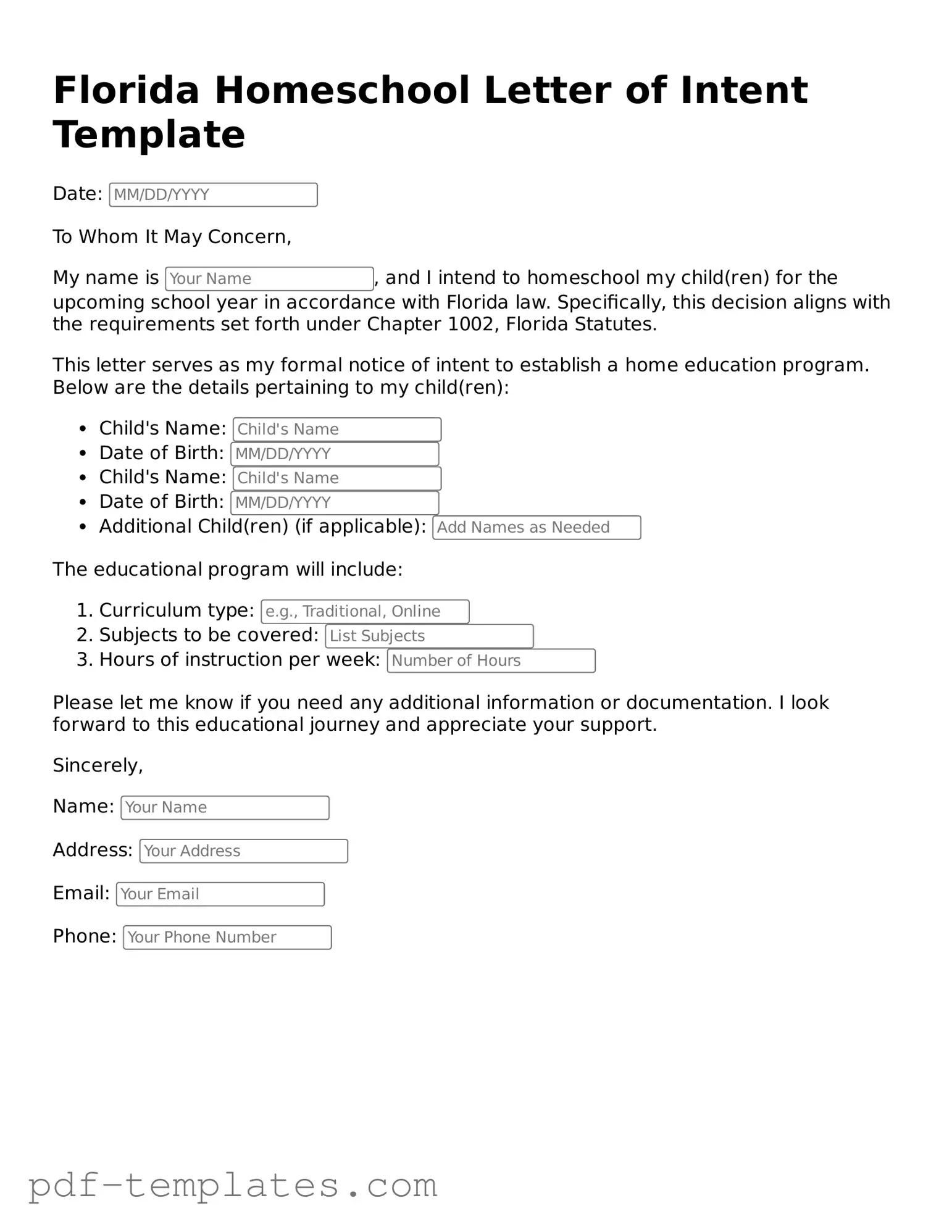The Florida Homeschool Letter of Intent form shares similarities with the Enrollment Form used by traditional schools. Both documents serve as formal notifications regarding a child's educational status. While the Enrollment Form is submitted to a school district, the Homeschool Letter of Intent is directed to the local school board. Each form requires the parent's or guardian's signature, indicating their commitment to the educational path chosen for the child. Additionally, both documents typically ask for basic information about the student, such as name and age, to ensure proper record-keeping.
Another document that resembles the Florida Homeschool Letter of Intent is the Private School Enrollment Form. Like the Homeschool Letter of Intent, this form is used to declare a child's educational setting. Parents must provide similar information, including the child's name and date of birth. Both forms also require a declaration of intent to educate the child in a non-public setting. The main distinction lies in the fact that the Private School Enrollment Form is used for students attending private institutions, while the Homeschool Letter of Intent is specific to home education.
In addition to the various forms discussed, it is also essential to consider the California Loan Agreement form, which serves as a legally binding document outlining the terms between a borrower and lender. This form ensures clarity and protects both parties in financial transactions by detailing the loan's specifics such as amount and repayment terms. To explore more about drafting such agreements in California, visit https://formcalifornia.com/.
The Withdrawal Form from a public school is another document that bears resemblance to the Homeschool Letter of Intent. When a parent decides to withdraw their child from a public school to pursue homeschooling, they often need to fill out a Withdrawal Form. This document notifies the school of the change in the child's educational status. Similar to the Homeschool Letter of Intent, it includes essential details about the student and requires the parent's signature. Both forms serve to officially document a transition in the child's education.
The Affidavit of Intent to Homeschool is also comparable to the Florida Homeschool Letter of Intent. This affidavit is a legal document that parents may be required to submit in some jurisdictions to formally declare their intent to homeschool. While the Homeschool Letter of Intent is more straightforward and specific to Florida, both documents emphasize the parent's commitment to providing an educational experience outside the traditional school system. They often require similar information regarding the student and the educational plan.
The Notification of Intent to Homeschool, found in various states, serves a purpose akin to the Florida Homeschool Letter of Intent. This document is submitted to local education authorities to inform them of a family's decision to homeschool. Both forms typically require basic student information and a declaration of the educational approach being taken. The Notification of Intent to Homeschool may vary in format and requirements from state to state, but the underlying intent is similar to that of the Florida form.
The Home Education Program Registration Form is another document that aligns closely with the Florida Homeschool Letter of Intent. This form is often required in states that have specific registration processes for homeschooling. Like the Homeschool Letter of Intent, it seeks to inform the educational authorities about a family's decision to educate their child at home. Both documents generally require similar details, including the child's name, age, and the educational plan to be followed.
Lastly, the Child's Educational History Form may also be seen as similar to the Florida Homeschool Letter of Intent. This document is often requested when a child transitions from one educational setting to another, including from a public school to homeschooling. It provides a summary of the child's previous educational experiences. While the Florida Homeschool Letter of Intent focuses on the intent to homeschool, both documents share the goal of ensuring that the child's educational background is appropriately recorded and considered in their new educational journey.
